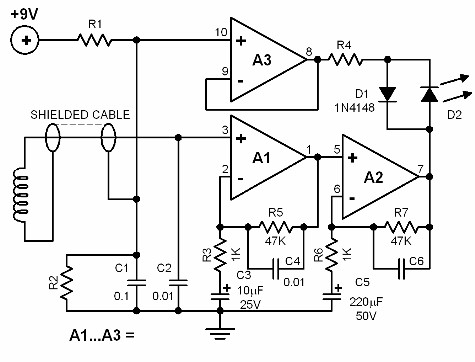
live wire sensor

This electronic device functions similarly to a metal detector but has a unique capability: it detects live electrical wires. This gadget is particularly beneficial for electricians engaged in repair or renovation tasks. The ability to locate hidden wires significantly minimizes the risk of damaging or cutting through them, ensuring a safer and more efficient job. This circuit is specifically designed to locate live wires embedded within non-metallic walls, such as concrete or wood. The current detector utilized is a standard telephone pick-up coil, which simplifies the circuit's construction compared to the process of winding a custom detector coil. The telephone pick-up coil detects the magnetic field generated by a live wire.
This device operates by utilizing the principle of electromagnetic induction. When an alternating current flows through a live wire, it produces a magnetic field around it. The telephone pick-up coil, designed to sense variations in magnetic fields, is positioned near the wall where the wires are suspected to be located. As the coil approaches the live wire, it detects the magnetic field and generates an electrical signal proportional to the field's strength.
The circuit typically consists of the following components: a power supply, a telephone pick-up coil, an amplifier, and a visual or audible indicator (such as an LED or buzzer). The power supply provides the necessary voltage to the circuit, while the amplifier boosts the signal received from the pick-up coil. The indicator provides feedback to the user, alerting them to the presence of live wires.
To enhance the functionality of the device, it may include features such as adjustable sensitivity, allowing the user to fine-tune the response to various wire depths and materials. Additionally, a multi-range switch could be implemented to adapt the device for different wall thicknesses or types of construction materials.
In terms of safety, this wire detection device is invaluable in preventing accidental contact with live electrical circuits, which can lead to serious injuries or damage. By integrating this technology into their toolkit, electricians can work more confidently and efficiently, minimizing the risk associated with electrical repairs or renovations. Overall, the design and operation of this circuit reflect a practical application of electromagnetic principles in everyday tasks.This electronic device works similar to a metal detector but it does something special: it detects live electrical wires. Such a gadget is highly useful for electricians doing repair or renovation jobs. Being able to detect hidden wires will highly reduce the risk of damaging or cutting through them thus making the job safe and fast.
This circuit is specially designed for locating live wires embedded inside non-metallic walls like concrete or wood. The actual current detector used is an ordinary telephone pick-up coil. This makes the construction of the circuit much simpler compared to winding your own detector coil. The telephone pickup coil detects the magnetic field created by a live wire. 🔗 External reference
This device operates by utilizing the principle of electromagnetic induction. When an alternating current flows through a live wire, it produces a magnetic field around it. The telephone pick-up coil, designed to sense variations in magnetic fields, is positioned near the wall where the wires are suspected to be located. As the coil approaches the live wire, it detects the magnetic field and generates an electrical signal proportional to the field's strength.
The circuit typically consists of the following components: a power supply, a telephone pick-up coil, an amplifier, and a visual or audible indicator (such as an LED or buzzer). The power supply provides the necessary voltage to the circuit, while the amplifier boosts the signal received from the pick-up coil. The indicator provides feedback to the user, alerting them to the presence of live wires.
To enhance the functionality of the device, it may include features such as adjustable sensitivity, allowing the user to fine-tune the response to various wire depths and materials. Additionally, a multi-range switch could be implemented to adapt the device for different wall thicknesses or types of construction materials.
In terms of safety, this wire detection device is invaluable in preventing accidental contact with live electrical circuits, which can lead to serious injuries or damage. By integrating this technology into their toolkit, electricians can work more confidently and efficiently, minimizing the risk associated with electrical repairs or renovations. Overall, the design and operation of this circuit reflect a practical application of electromagnetic principles in everyday tasks.This electronic device works similar to a metal detector but it does something special: it detects live electrical wires. Such a gadget is highly useful for electricians doing repair or renovation jobs. Being able to detect hidden wires will highly reduce the risk of damaging or cutting through them thus making the job safe and fast.
This circuit is specially designed for locating live wires embedded inside non-metallic walls like concrete or wood. The actual current detector used is an ordinary telephone pick-up coil. This makes the construction of the circuit much simpler compared to winding your own detector coil. The telephone pickup coil detects the magnetic field created by a live wire. 🔗 External reference





